|
|
|
 |
|
|
|
|
|
|
|
The Railway and Station
|
|
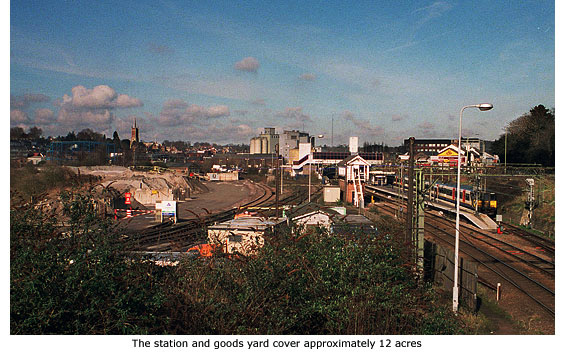 |
|
|
|
The steam locomotive was invented in 1803 by Richard Trevithick, and the first public steam railway in the world to convey goods and passengers was the Stockton to Darlington railway on 27 September 1825. At the controls was George Stephenson with his second engine, the Locomotion.
This led, in 1829, to the building of the first intercity railway between Liverpool and Manchester, and that same year a competition – the Rainhill Locomotive Trials – was organised to build a train that would be faster and use less coal. It was won conclusively by George Stephenson’s Rocket travelling at 30 mph. His triumph marked the start of the golden age of the railway and before long, towns and cities throughout the country all wanted their own railway connections. By the end of that decade over 1500 miles of track had been laid.
One early proposal that would have put Bishop’s Stortford on the main line route to the North and Scotland was put forward by the Grand Northern Railway Company (GNR), who wanted to build a line linking London to the northern coal and industrial centres. Dubbed the ‘Cathedral Route’, it was to run via Bishop’s Stortford, Cambridge, Lincoln, York and Edinburgh, but the plan coincided with a national depression and failed to get the financial support it needed.
In 1833, the Eastern Counties Railway Company (ECR) had plans to build a line from their terminus at Shoreditch, London, to Yarmouth – via Colchester and Norwich – at the same time as the Northern & Eastern Railway Company (NER) was proposing to reintroduce the ‘Cathedral Route’ to run from a terminus in London, and for which the necessary Act of Incorporation was passed by parliament in 1836.
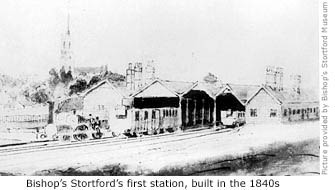 But once again the route was doomed to fail as NER’s plans were also curtailed by financial difficulties, this time largely aggravated by landowners of the proposed terminus site at Islington holding out for exorbitant land prices, far in excess of the company’s finances. The prospect of NER having a railway without a London terminus quickly led to talks with Eastern Counties Railway, who had already built their terminus at Shoreditch. A mutual agreement was secured whereby NER were allowed to use the lines of ECR from Stratford into Shoreditch, but only after a junction had been built at Stratford to link with NER’s main line that started at Tottenham. But once again the route was doomed to fail as NER’s plans were also curtailed by financial difficulties, this time largely aggravated by landowners of the proposed terminus site at Islington holding out for exorbitant land prices, far in excess of the company’s finances. The prospect of NER having a railway without a London terminus quickly led to talks with Eastern Counties Railway, who had already built their terminus at Shoreditch. A mutual agreement was secured whereby NER were allowed to use the lines of ECR from Stratford into Shoreditch, but only after a junction had been built at Stratford to link with NER’s main line that started at Tottenham.
But further financial problems arose. Even though NER now had access to a London terminus, the expense of constructing a line past Bishop’s Stortford to the North wasn’t considered viable and the planned route was temporarily abandoned. There had also been problems with landowners between Bishop’s Stortford and Cambridge who proved difficult and obstructive, but it was thought once they realised the financial benefits that would come from the London/Bishop’s Stortford line, they would then allow the railway access over their lands.
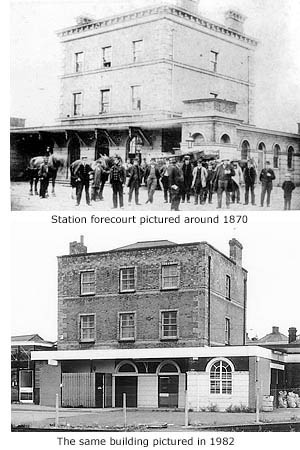 The estimated cost of the 30 miles of track between Stratford – the new junction with ECR – and Bishop’s Stortford was £480,000, and the task of construction was awarded to Sir Samuel Morton Peto, an experienced engineer in track building both here and abroad. A broad gauge of 5 feet was adopted to conform with the track width of ECR and work began in 1839, the first section of ECR track being opened from a temporary terminus at Mile End. The estimated cost of the 30 miles of track between Stratford – the new junction with ECR – and Bishop’s Stortford was £480,000, and the task of construction was awarded to Sir Samuel Morton Peto, an experienced engineer in track building both here and abroad. A broad gauge of 5 feet was adopted to conform with the track width of ECR and work began in 1839, the first section of ECR track being opened from a temporary terminus at Mile End.
On 1 July 1840, trains began to use the still unfinished Shoreditch terminus. The route proved relatively easy to build; the first section of 16 miles from Shoreditch to Broxbourne opening on 15 September 1840. By August the following year the track had reached Harlow, and on 16 May 1842 the first train from London steamed into Bishop’s Stortford.
The railway was an immediate success and the following year the proprietors applied to extend the line a further 10 miles to Newport in Essex – the necessary power of land purchase being granted by Parliament. An agreement was also made at this time between NER and ECR that resulted in the former company being leased to the latter for a period of 999 years.
ECR then sought permission to extend the line a further 46 miles from Newport to Brandon in Suffolk, the southern-most point of Norfolk Railway’s main line from Norwich, which was then under construction. That same year (1844) it was decided the entire line from London should be converted from broad gauge (5ft) to the new standard 4ft 8 1/2” gauge, an enormous task but one that actually took less than a month to complete. On 30 July 1845 the section from Bishop’s Stortford to Brandon met with the section from Norwich, and the link between London and Norwich – via Bishop’s Stortford, Cambridge and Ely – was complete.
By 1862 most of the separate undertakings in East Anglia were merged into Great Eastern Railway (GER), the exception being NER, which continued to be leased to Eastern Counties Railway until 1902 when it finally amalgamated.
The railway was the catalyst that fused together all the elements of the Industrial Revolution, creating a national transport system whereby people and freight could be moved around the country with ease. It was to be the death of long-distance horse transport as well as the canal system that had held the monopoly on transportation for so long. Locally, the Stort Navigation would also eventually become a victim.
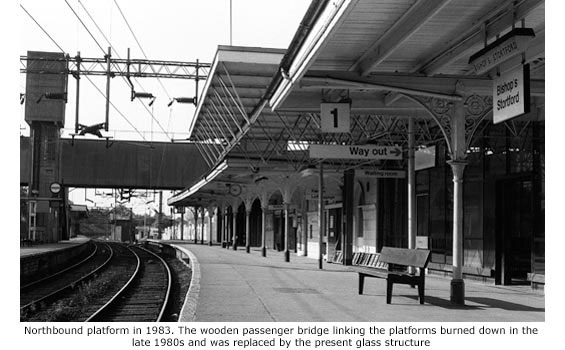
The arrival of the railway had a profound effect on the town and certainly wasn’t greeted with open-arms by all. The coaching trade was the first to be affected, Bishop’s Stortford’s most prominent coach proprietor, Henry Gilbey, losing his business almost immediately (See Guide 4).
Initially, the malting industry continued to thrive but in the coming years the Stort Navigation suffered tremendously from lack of revenue: so much so that in 1911 the directors sold their interest in it to the Lee Conservancy Board for the nominal sum of five shillings (25p).
On the plus side, the arrival of the railway was the principle reason for the development of New Town, keenly promoted by the Conservative Land Society and GER (See Guide 14), and in the late 1800s it was fundamental to Sir Walter Gilbey’s building of Hockerill Park Estate (See Guide 12).
Within five months of the railway reaching Bishop’s Stortford the Mail coach service disappeared, as did the Post houses, but horses were still used for delivering mail to rural areas. Some local innkeepers, never slow to seize an opportunity, had ‘conveyances’ meet every train arriving at the station for the ‘mutual convenience’ of passengers and themselves.
Bishop’s Stortford’s first station was encased in a large canopy construction, not dissimilar to those now found at major London terminus buildings. The main station building of today was originally the stationmaster’s house, built between 1842 and 1847, which also accommodated the parcels office. Victorian cast-iron supports and wooden roof canopy are still to be found on the northbound platform, although the southbound ‘island’ platform has been much modernised. The main building and its accommodation was completely refurbished in 1891, and three years later the goods office was enlarged to accommodate ‘two’ extra staff. Towards the end of the 1890s a detached booking office was built on the London Road side of the station by local builder J.L. Glasscock, at a cost of £960.
|
|
|
|
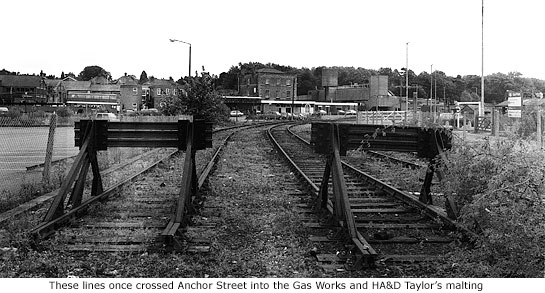 |
|
|
|
The station and goods yard covered an area of approximately 12 acres – that part of it to the south of Dane Street built on a field previously known as Sextons Mead – and up until the present time, it remains Bishop’s Stortford’s largest ever single construction. On the site of today’s main commuter car park, adjacent to Station Road, two sidings led to a large goods shed, while another two served an even larger granary standing alongside it. Surprisingly, there wasn’t considered to be enough space here to build an engine shed, but a turntable and inspection pit was located at the north end of the southbound platform, entered by a siding on the east side of the track.
Further track ran through the yard’s western boundary gate and across Anchor Street, directly into the Gas Works and riverside malthouses owned by HA & D Taylor, and to the south of the station was a loading dock and crane, plus five reception sidings mainly used for coal storage. Road transport vehicles entered the yard through a gate in London Road opposite the Tanners Arms public house. The transportation of cattle was a natural business for this market town, and three large pens were situated on that part of the yard once leased by Aggregates Industries UK. The firm moved to Harlow in 2004.
Bishop’s Stortford was certainly a busy and industrious station. In 1893 it handled 205,000 tons of barley and malt along with countless tons of vegetables, straw and hay, all destined for London’s markets. In the early 1900s, countless Shire horses used by London breweries and coal merchants were transported here by train each July, then left for a month or so to graze and rest in the pastures of local farms. Oddly enough, right up until the late 1930s, horses were still stabled at the station and used to move goods wagons around the sidings.
During times of conflict countless troops have been waved goodbye from the station’s platforms, the most notable occasions being the Boer War (1900), the First World War (1914–1918), and the Second World War (1939–1945). Strangely, Bishop’s Stortford was virtually ignored by German bombers during the Second World War, even though the railway station was a suitably large and important target.
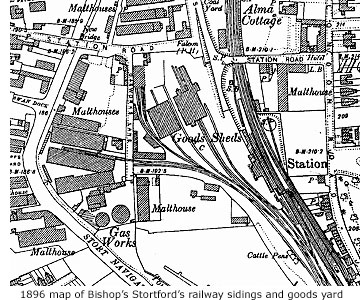 The only recorded incident of enemy attack on the station itself was when a lone German Dornier bomber, perhaps on its way home, flew close to the ground above the southbound track and released its bombs on sidings opposite the Tanners Arms in London Road. They could have been aimed at one of the many ammunition trains that regularly passed through the station supplying the United States Air Force base at Stansted but did, in fact, hit and destroy several wagons containing sugar beet. Fortunately the attack happened one Sunday lunchtime and with few people around no one was injured. The only recorded incident of enemy attack on the station itself was when a lone German Dornier bomber, perhaps on its way home, flew close to the ground above the southbound track and released its bombs on sidings opposite the Tanners Arms in London Road. They could have been aimed at one of the many ammunition trains that regularly passed through the station supplying the United States Air Force base at Stansted but did, in fact, hit and destroy several wagons containing sugar beet. Fortunately the attack happened one Sunday lunchtime and with few people around no one was injured.
Only one serious rail crash has occurred at the station throughout its long history. On the afternoon of 10 May 1926, a slow Cambridge to London passenger and milk train had just pulled into the station when it was struck from the rear by a goods train travelling in the same direction. The guards van and milk van were telescoped and forced up, causing the canopy roof above the platform to collapse. One railway worker was seriously injured but as rescuers cleared the debris a passenger was found beneath it, crushed to death by the falling roof.
In 1958 the remodelling of Bishop’s Stortford station began in conjunction with the North East London Suburban Electrification scheme. The North signal box was demolished in 1960 and control of all trains was then operated from the South signal box. That same year a new enclosed wooden footbridge, complete with parcel lift, was built to link the extended platforms, but this burned down in the 1980s and was replaced by the present structure.
The new electric service was inaugurated on 16 November 1960 and the service opened to the public four days later – officially ending steam traction on the suburban services from Bishop’s Stortford.
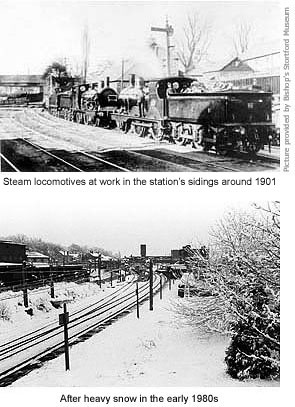 When the steam depot finally closed in 1962, the redundant circular water tower that stood alongside the track on the northbound platform was cleverly transformed and converted into offices. Modernisation of the station structure in 1962/3 included preservation of the main building and the addition of a glazed booking hall with steel-framed roof. When the steam depot finally closed in 1962, the redundant circular water tower that stood alongside the track on the northbound platform was cleverly transformed and converted into offices. Modernisation of the station structure in 1962/3 included preservation of the main building and the addition of a glazed booking hall with steel-framed roof.
Bishop’s Stortford was the outer terminus of Liverpool Street’s North Eastern electric service until 1986 when electrification of the line was then extended to Cambridge. Diesel locomotives continued to be used for express passenger services between Norwich, Cambridge, Bishop’s Stortford and London, but ceased to operate shortly after.
By 1869 the Bishop’s Stortford, Dunmow and Braintree branch line had been completed, its original route veering off eastwards from the main line about half a mile north of the station. The last section of the branch line was removed in 1974, but in the mid 1980s a new spur was created a few miles further north to service newly built Stansted Airport with high-speed trains from Liverpool Street Station.
The northern end of the goods yard was eventually turned into a car park for commuters, and in 1986 British Rail sold part of this land for the building of the present bus terminus. During its construction, workmen unearthed the remains of an old railway turntable and a pair of wide gauge locomotive wheels, complete with axle.
After privatisation of British Rail in 1997, it was restructured into approximately 100 separate companies with operating and maintenance consortium Railtrack plc at its core. Established in 1994, Railtrack’s ability to maintain such a large rail network was often called into question and in 2001 the company was pushed into Administration by the government and replaced by a non-profit organisation.
From 1997 the London to Cambridge line was operated under franchise by West Anglian Great Northern Railway (WAGN), but in April 2004 the new seven year franchise was awarded to National Express Group plc.
The station forecourt was redesigned in 1999, and a £100m redevelopment scheme for the goods yard was given the go-ahead in 2004. This will include a mixture of housing, shops, parking, commercial, marina and leisure uses, and a new public transport interchange. More importantly, a link road will be constructed between London Road and Dane Street/Station Road to relieve congestion at Hockerill. MORE PICTURES

|
|
|
|
[ BACK TO TOP ] |
|
|
|
|
|
|
|
|
|





 But once again the route was doomed to fail as NER’s plans were also curtailed by financial difficulties, this time largely aggravated by landowners of the proposed terminus site at Islington holding out for exorbitant land prices, far in excess of the company’s finances. The prospect of NER having a railway without a London terminus quickly led to talks with Eastern Counties Railway, who had already built their terminus at Shoreditch. A mutual agreement was secured whereby NER were allowed to use the lines of ECR from Stratford into Shoreditch, but only after a junction had been built at Stratford to link with NER’s main line that started at Tottenham.
But once again the route was doomed to fail as NER’s plans were also curtailed by financial difficulties, this time largely aggravated by landowners of the proposed terminus site at Islington holding out for exorbitant land prices, far in excess of the company’s finances. The prospect of NER having a railway without a London terminus quickly led to talks with Eastern Counties Railway, who had already built their terminus at Shoreditch. A mutual agreement was secured whereby NER were allowed to use the lines of ECR from Stratford into Shoreditch, but only after a junction had been built at Stratford to link with NER’s main line that started at Tottenham. The only recorded incident of enemy attack on the station itself was when a lone German Dornier bomber, perhaps on its way home, flew close to the ground above the southbound track and released its bombs on sidings opposite the Tanners Arms in London Road. They could have been aimed at one of the many ammunition trains that regularly passed through the station supplying the United States Air Force base at Stansted but did, in fact, hit and destroy several wagons containing sugar beet. Fortunately the attack happened one Sunday lunchtime and with few people around no one was injured.
The only recorded incident of enemy attack on the station itself was when a lone German Dornier bomber, perhaps on its way home, flew close to the ground above the southbound track and released its bombs on sidings opposite the Tanners Arms in London Road. They could have been aimed at one of the many ammunition trains that regularly passed through the station supplying the United States Air Force base at Stansted but did, in fact, hit and destroy several wagons containing sugar beet. Fortunately the attack happened one Sunday lunchtime and with few people around no one was injured. When the steam depot finally closed in 1962, the redundant circular water tower that stood alongside the track on the northbound platform was cleverly transformed and converted into offices. Modernisation of the station structure in 1962/3 included preservation of the main building and the addition of a glazed booking hall with steel-framed roof.
When the steam depot finally closed in 1962, the redundant circular water tower that stood alongside the track on the northbound platform was cleverly transformed and converted into offices. Modernisation of the station structure in 1962/3 included preservation of the main building and the addition of a glazed booking hall with steel-framed roof.